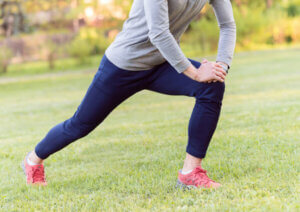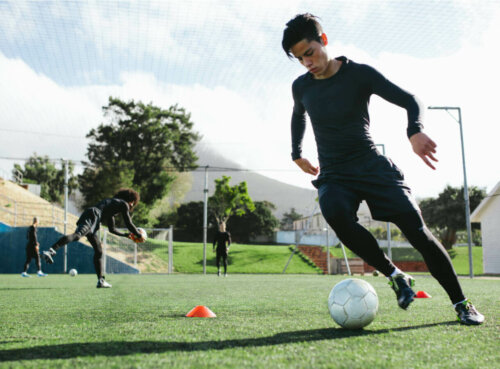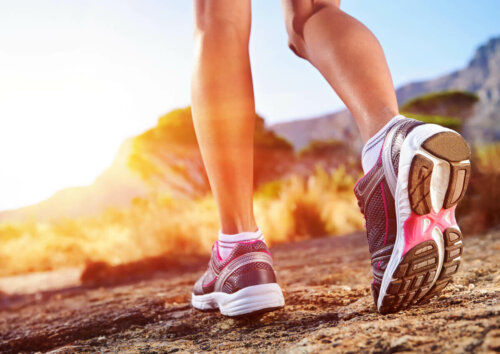6 Keys to Taking Care of Your Knees While Exercising

Taking care of your knees when doing sports is pretty essential. After all, it’s the joint that allows you to flex and extend your leg. Additionally, you use your knees every day, whether you’re an athlete or not. This is why you must be careful not to injure them.
Up next, we’re going to examine some of the keys to taking care of your knees and keeping them in the best possible condition. Applying these tips on a daily basis will help you to have a good quality of life, not only during your youth but also as you become older.
1. Muscle strength
A great key to taking care of your knees when exercising is to increase the muscular strength of your legs. The stronger your muscles are, the more weight they’re able to carry. In this way, they remove this responsibility from the joint, in addition to helping it maintain its stability.
Also, having strong muscles will make you less likely to suffer from an injury. When the muscles work as they should, movements are less likely to hurt the surrounding areas. Instead, all movements will be more natural, even when you make one that requires great strength or speed.
Lastly, you must make sure you have enough strength to perform the training you desire. In other words, you shouldn’t increase the load or sports intensity in a sudden manner. Believe it or not, it’s necessary to give your muscles time to gradually increase in size.
2. Cross-training
This is a good way to maintain the health, not only of the knees but of muscles and soft tissues in general. In fact, a study published by Medicina de l’Esport defines cross-training as the discipline where different sports are performed. Basically, not limiting oneself to just playing soccer every day, for example.
Each sport has a different impact on the structures of the body. Some of them put more stress on some muscles than others. It’s safe to say that each sport discipline is a universe in itself; some of them require the legs to be stronger and resistant than others.
That being said, if you don’t mix exercises from other sports, you’re continually impacting the same structures in the same way. That’ll for sure predispose you to joint-wear problems, problems with the menisci, ligaments, tendons, among others.
Secondly, cross-training is also important for balanced muscle strength. Let’s consider the previous example. Think about someone who only plays soccer – basically, they spend a lot of their time kicking a ball. In that case, they’ll have very strong quadriceps, but the hamstrings won’t receive strength training.
This situation can make the person more susceptible to suffering from hamstring stretches or tears since there’s a muscular imbalance. In brief, if you include training sessions from other sports, your body will definitely be more balanced.

3. Taking care of your knees: the importance of warming up and stretching
One key to taking care of your knees while exercising is letting your muscles do their job. Performing a correct and complete warm-up prepares all the structures of the body for the effort that lies ahead. If you don’t do this, none of those body parts will be ready and won’t be able to perform their function.
Something similar happens if you don’t stretch after training. In case you didn’t know, this is important in order to maintain good elasticity. Muscles tend to seize and retract, pulling too hard on the structures into which they’re attached. If this happens, the chance of injury increases significantly.
4. Correct sports gestures
Most sports have been practiced for decades. Therefore, for all of them, researchers have carried out biomechanical studies that have shown the least harmful ways to perform their sporting gestures.
You must make sure you take care of each sport’s technique and follow their tips. If you like to swim, for example, moving in the water correctly will help protect your knees, hips, shoulders, and back.
5. Taking care of your feet is imperative
Although we’re talking about knee health here, we must talk about foot health. These two go hand-in-hand in this case. Any deviation that causes you to step incorrectly will directly affect your knees.
Therefore, if you practice sports frequently, we advise you to go to a podiatrist. On the other hand, if you do occasional sports but notice some discomfort in the joint, it may be caused by foot problems.
In this sense, you should also use quality equipment when doing sports. Shoes, for example, must be suitable for the surface on which you’re exercising.

6. Control your weight
We couldn’t finish off this article without mentioning body weight. The greater the weight, the greater the work your knees will have to carry out.
Because of this, it’s important to keep a healthy and balanced diet and try to lose weight if you’re overweight. With these precautions, it’ll be possible for you to play sports safely.
Taking care of your knees when doing sports is pretty essential. After all, it’s the joint that allows you to flex and extend your leg. Additionally, you use your knees every day, whether you’re an athlete or not. This is why you must be careful not to injure them.
Up next, we’re going to examine some of the keys to taking care of your knees and keeping them in the best possible condition. Applying these tips on a daily basis will help you to have a good quality of life, not only during your youth but also as you become older.
1. Muscle strength
A great key to taking care of your knees when exercising is to increase the muscular strength of your legs. The stronger your muscles are, the more weight they’re able to carry. In this way, they remove this responsibility from the joint, in addition to helping it maintain its stability.
Also, having strong muscles will make you less likely to suffer from an injury. When the muscles work as they should, movements are less likely to hurt the surrounding areas. Instead, all movements will be more natural, even when you make one that requires great strength or speed.
Lastly, you must make sure you have enough strength to perform the training you desire. In other words, you shouldn’t increase the load or sports intensity in a sudden manner. Believe it or not, it’s necessary to give your muscles time to gradually increase in size.
2. Cross-training
This is a good way to maintain the health, not only of the knees but of muscles and soft tissues in general. In fact, a study published by Medicina de l’Esport defines cross-training as the discipline where different sports are performed. Basically, not limiting oneself to just playing soccer every day, for example.
Each sport has a different impact on the structures of the body. Some of them put more stress on some muscles than others. It’s safe to say that each sport discipline is a universe in itself; some of them require the legs to be stronger and resistant than others.
That being said, if you don’t mix exercises from other sports, you’re continually impacting the same structures in the same way. That’ll for sure predispose you to joint-wear problems, problems with the menisci, ligaments, tendons, among others.
Secondly, cross-training is also important for balanced muscle strength. Let’s consider the previous example. Think about someone who only plays soccer – basically, they spend a lot of their time kicking a ball. In that case, they’ll have very strong quadriceps, but the hamstrings won’t receive strength training.
This situation can make the person more susceptible to suffering from hamstring stretches or tears since there’s a muscular imbalance. In brief, if you include training sessions from other sports, your body will definitely be more balanced.

3. Taking care of your knees: the importance of warming up and stretching
One key to taking care of your knees while exercising is letting your muscles do their job. Performing a correct and complete warm-up prepares all the structures of the body for the effort that lies ahead. If you don’t do this, none of those body parts will be ready and won’t be able to perform their function.
Something similar happens if you don’t stretch after training. In case you didn’t know, this is important in order to maintain good elasticity. Muscles tend to seize and retract, pulling too hard on the structures into which they’re attached. If this happens, the chance of injury increases significantly.
4. Correct sports gestures
Most sports have been practiced for decades. Therefore, for all of them, researchers have carried out biomechanical studies that have shown the least harmful ways to perform their sporting gestures.
You must make sure you take care of each sport’s technique and follow their tips. If you like to swim, for example, moving in the water correctly will help protect your knees, hips, shoulders, and back.
5. Taking care of your feet is imperative
Although we’re talking about knee health here, we must talk about foot health. These two go hand-in-hand in this case. Any deviation that causes you to step incorrectly will directly affect your knees.
Therefore, if you practice sports frequently, we advise you to go to a podiatrist. On the other hand, if you do occasional sports but notice some discomfort in the joint, it may be caused by foot problems.
In this sense, you should also use quality equipment when doing sports. Shoes, for example, must be suitable for the surface on which you’re exercising.

6. Control your weight
We couldn’t finish off this article without mentioning body weight. The greater the weight, the greater the work your knees will have to carry out.
Because of this, it’s important to keep a healthy and balanced diet and try to lose weight if you’re overweight. With these precautions, it’ll be possible for you to play sports safely.
All cited sources were thoroughly reviewed by our team to ensure their quality, reliability, currency, and validity. The bibliography of this article was considered reliable and of academic or scientific accuracy.
- J. Gallach y L. González. El entrenamiento cruzado: una posibilidad del mantenimiento de la forma ante lesiones unilaterales. Apunts. Medicina de l’Esport. Volume 38, Issue 141, Pages 5-8, 2003
- D. Knudson. Tenis : calentamiento deportivo. Estira después del partido, no antes. Alto rendimiento: ciencia deportiva, entrenamiento y fitness, Nº. 5, 2003
- E. Peña, B. Calvo y M- Doblaré. Biomecánica de la articulación de la rodilla tras lesiones ligamentosas. Revista Internacional de Métodos Numéricos para Cálculo y Diseño en Ingeniería. Vol. 22, núm.1. 2006
This text is provided for informational purposes only and does not replace consultation with a professional. If in doubt, consult your specialist.








